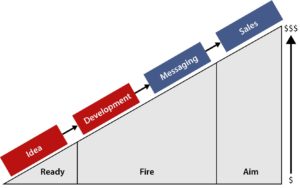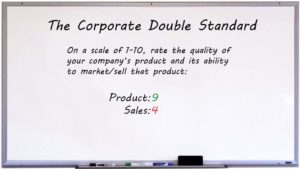Some years ago, we were working with a client that provided medical product development services. Many of their prospects struggled to manage the run-time between concept and commercialization – let alone profitability. They would burn through their budget short of milestones and fizzle or bleed equity. IntelliSource crafted the position of the “Milestone Methodology to test ideas, not budgets.” It’s a great philosophy for all companies, not just in the medical space, and applies as much to messaging and positioning as it does product development. But how do you achieve it?
Often companies follow a linear progression of steps between concept and commercialization looking something like this:

Companies ideate, fund product development and testing, craft messaging and marketing, and then go to market. The problem is major resources are spent before the most important questions have been asked and answered: does the market want this product/service and what is its value? This ready-fire-aim approach is an uphill battle. Product development is more difficult without a deep understanding of market needs and competing offerings. Messaging tends to become product-centric rather than solution-centric. And it can lead to significant strategic and economic setbacks.
Alternatively, if instead of asking critical customer-facing question on the backend, we ask and answer them on the frontend, a remarkable thing happens. The progression looks more like this:

This is ready-aim-fire; marketing informs product development and becomes an integral part of a system with quicker insights, evolutions, and advancements toward delivering a viable, superior, and valuable offering. By investing in message development concurrently with product development and involving customers in the process, both product and message become solution-based. This results in very compelling and effective messages when you commercialize. Furthermore, for early stage companies few things build value better than a customer validating the concept, market need, and willingness to pay. We see it happen all the time.
While working with our client on a cardiopulmonary bypass pump we employed front-end customer strategy and the milestone methodology. IntelliSource helped craft a presentation to win grant funding for prototype development and testing of the idea. When the prototype had been developed and tested, we interviewed and filmed one of the preeminent pioneers in cardiac surgery admonishing the current practice, claiming the incumbents recognized the problems with their technologies but struggled to overcome them, and lauding our client’s approach as the future standard of care in a multi-billion-dollar market. Furthermore, we crafted a separate video and presentation winning a National Institute of Health pitch fest. Only once armed with a solution-based message backed by expert validation of the concept and commercial potential did our client conduct another funding round to advance through regulatory testing and a path to commercialization.
In another example, IntelliSource arranged first-ever end-user meetings for a leading plastic cable tie manufacturer. During frontend discovery meetings with the end users, we discovered one of their greatest challenges was not the ties or putting them on but rather taking them off. If they cut a cable while removing a tie, miles of cable would have to be rerun. This conversation led to the invention of a new patented cutoff tool which has produced millions in new revenue.
The advantages of frontend market research are innumerable – as much about identifying what to do as identifying what not to do, conserving budgets or pivoting based on the market. Furthermore, when experts in backend sales orchestrate frontend research, they can better ask and uncover the answers to those critical questions – will it sell and is it valuable. Furthermore, frontend customer research provides a tremendous opportunity to foster customer relationships laying the groundwork for testimonials, marketing collateral, and customer-to-customer selling when you do commercialize and go to market. The adage holds true, “Ask for money and you get advice; ask for advice and you get money.” An effective discovery conversation often transitions to a conversation advancing early adopters and development partners.
In strategic positioning, customers are the best calibration of true north to help companies navigate toward high-growth and high-profit opportunities. To learn more about how we work in the trenches with companies to go from defining a position in the competitive landscape to dominating it, read more about our process.




